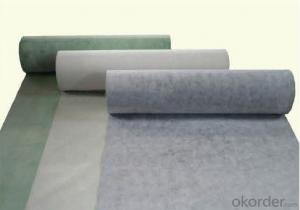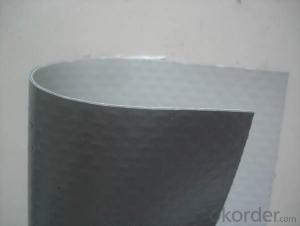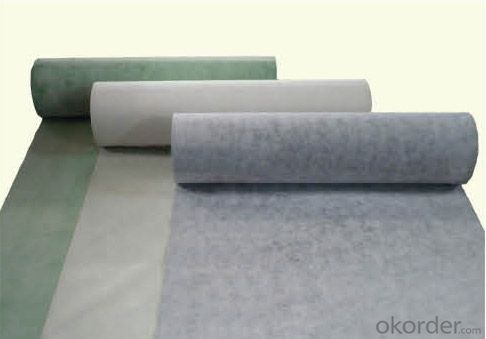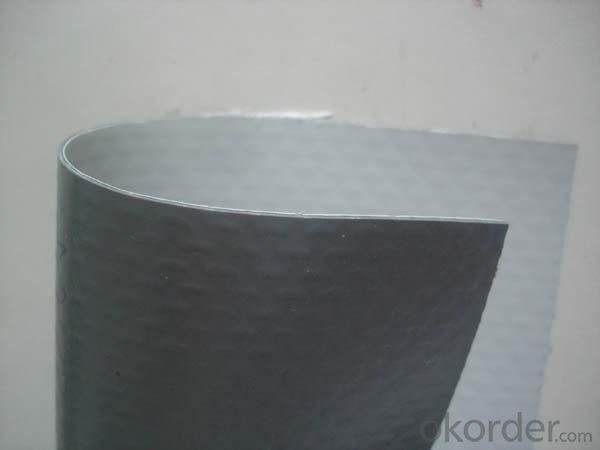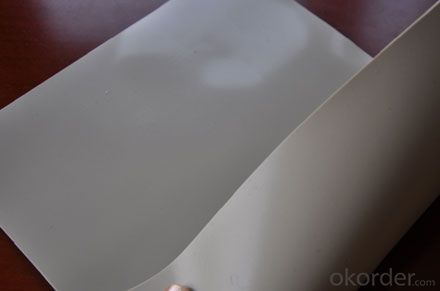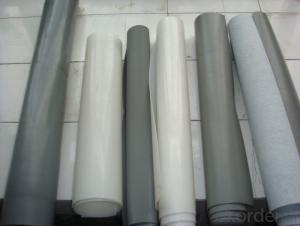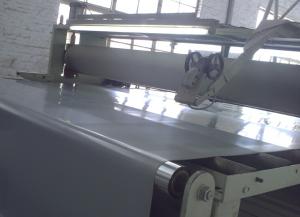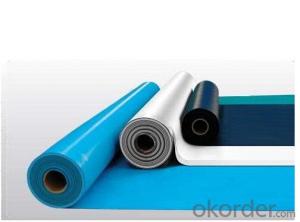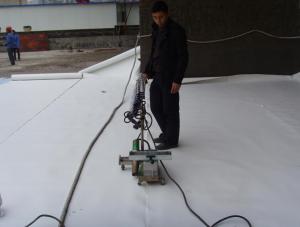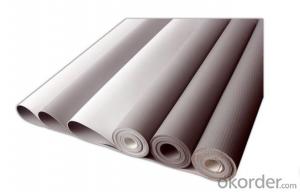PVC Roofing and Waterproofing Membrane Rolls
- Loading Port:
- China main port
- Payment Terms:
- TT OR LC
- Min Order Qty:
- 5000 m²
- Supply Capability:
- 100000 m²/month
OKorder Service Pledge
OKorder Financial Service
You Might Also Like
PVC membrane Product Description:
PVC waterproofing roofing membrane are based upon Polyvinyl Chloride Resin
with other additives to provide flexibility and stability. It gives a good performance of
anti-oxidant, absorbent of ultraviolet light, plasticizer and plastic filling agent.
Product Classification:
Product is classified by felt:
1. Product without felt
2. product with single-ply fibre
3. product with fabric reinforcement
Every type of product is classified into kind Ⅰand Ⅱbased on physical property.
PVC membrane Product Specification:
Length: 10m, 15m, 20m
Thickness: 1.2mm, 1.5mm, 2.0mm
Width: 2.05m
PVC membrane Physical Performance
Class L: Product with single-ply fibre
Class W: Product with fabric reinforcement
PVC membrane Application Range:
PVC waterproof membrane forms an effective barrier to liquid water or water vapor
in the steel structure for industrial and civil engineering, underground engineering, such as
subway, bridges , tunnel, water pools, shelter, grain depot, land filling and subway.
Products display
FAQ of PVC Waterproofing Membrane
a.Can we get some samples before place order?
Answer: We can send the free samples to you by freight collect.
b.How many years can your PVC membrane guarantee?
Answer: We will guarantee the quality for 5 years at least.
c.Which countries you ever export the product?
Answer: We export the PVC membrane to South Africa, Middle east and even European countries.
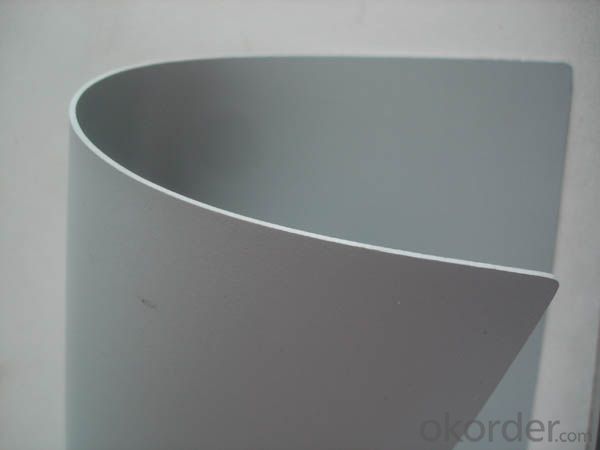
- Q: Can a waterproofing membrane prevent mold and mildew growth?
- Yes, a waterproofing membrane can help prevent mold and mildew growth. By creating a barrier that prevents water from seeping into the walls or floors, it reduces the moisture content in the environment, which is necessary for mold and mildew to thrive. This can effectively prevent their growth and minimize the potential for related health issues and structural damage.
- Q: Can a waterproofing membrane be used for wastewater treatment plants or sewage facilities?
- Yes, a waterproofing membrane can be used for wastewater treatment plants or sewage facilities. These facilities often require protection against water infiltration and leakage due to the presence of large amounts of water and potentially corrosive substances. A waterproofing membrane is a versatile solution that can provide a barrier against water penetration, helping to prevent damage to the structure and ensure the proper functioning of the facility. It can be applied to various areas such as walls, floors, roofs, and tanks, helping to maintain a watertight environment and prolong the lifespan of the facility. Additionally, some waterproofing membranes are specifically designed to withstand harsh chemicals, making them suitable for wastewater treatment plants and sewage facilities where corrosive substances may be present.
- Q: Can a waterproofing membrane be used on precast copper surfaces?
- Yes, a waterproofing membrane can be used on precast copper surfaces. The membrane will create a barrier that prevents water penetration, ensuring the durability and longevity of the copper surface.
- Q: Are waterproofing membranes suitable for commercial applications?
- Indeed, waterproofing membranes prove to be a fitting choice for commercial applications. Specifically designed to safeguard buildings, structures, and surfaces from water infiltration, moisture damage, and similar issues, waterproofing membranes are frequently employed in diverse commercial scenarios such as roofs, basements, underground parking garages, and exterior walls. Commercial structures face a wide array of weather conditions and water sources, encompassing rainfall, snowfall, and groundwater. Waterproofing membranes serve as a dependable barrier, effectively preventing water penetration and averting costly water-related harm. Furthermore, they serve as a vapor barrier, mitigating moisture accumulation and condensation within the building envelope, which may otherwise lead to mold growth and structural decay. Waterproofing membranes are obtainable in various materials including bitumen, modified bitumen, EPDM, PVC, and TPO. Each material boasts distinct advantages and characteristics, allowing for flexibility in choosing the most appropriate option for specific commercial applications. They can be applied as liquid coatings, sheets, or panels, providing versatility in terms of installation methods to accommodate diverse building designs and requirements. Moreover, waterproofing membranes can be tailored to cater to specific commercial needs such as fire resistance, UV protection, and durability. This renders them highly effective in safeguarding commercial properties that may be subjected to heavy foot traffic, mechanical equipment, or other potential sources of damage. To summarize, waterproofing membranes prove to be an exceptionally suitable solution for commercial applications. They offer reliable protection against water infiltration, moisture damage, and related issues, ensuring the longevity and structural soundness of commercial buildings. Their versatility, customizable options, and ability to withstand various weather conditions make them an outstanding choice for commercial waterproofing requirements.
- Q: Can a waterproofing membrane be used for a stadium roof?
- Yes, a waterproofing membrane can be used for a stadium roof. Waterproofing membranes are designed to provide a barrier against water infiltration and protect the underlying structure from moisture damage. Using a waterproofing membrane on a stadium roof can help prevent leaks and ensure the longevity of the roof.
- Q: Can a waterproofing membrane be used on precast cement board surfaces?
- Yes, a waterproofing membrane can be used on precast cement board surfaces. Precast cement board surfaces are commonly used in construction, especially for exterior applications. These surfaces are not inherently waterproof, so applying a waterproofing membrane can provide an extra layer of protection against water infiltration. A waterproofing membrane is a thin layer of material that is applied to the surface of the cement board. It forms a barrier that prevents water from penetrating the board and reaching the underlying structure. This is particularly important for areas that are exposed to moisture, such as bathrooms, kitchens, and outdoor installations. There are different types of waterproofing membranes available, including liquid-applied membranes and sheet membranes. Liquid-applied membranes are typically rolled or sprayed onto the surface, while sheet membranes are applied like a sticker. Both types provide an effective waterproofing solution for precast cement board surfaces. When choosing a waterproofing membrane for precast cement board surfaces, it is essential to consider the specific requirements and conditions of the project. Factors such as the level of water exposure, climate, and intended use of the surface should be taken into account. It is also important to follow the manufacturer's instructions for application, as proper installation is crucial for the effectiveness of the membrane. In conclusion, a waterproofing membrane can be used on precast cement board surfaces to provide additional protection against water infiltration. It is a wise choice for areas that are exposed to moisture and can help prolong the lifespan of the cement board and prevent damage to the underlying structure.
- Q: Can a waterproofing membrane be used in geotechnical applications?
- Yes, a waterproofing membrane can be used in geotechnical applications. Waterproofing membranes are commonly used to prevent the infiltration of water into structures and are applied to various surfaces such as roofs, basements, and foundations. In geotechnical applications, these membranes can be utilized to prevent water from seeping into soil, preventing erosion, and stabilizing slopes. They can be installed horizontally or vertically to create a barrier that prevents water penetration, which can be particularly useful in retaining walls, embankments, and dams. Additionally, waterproofing membranes can also be used to control the flow of water and improve drainage in geotechnical projects. Overall, the use of a waterproofing membrane in geotechnical applications can enhance the durability and performance of structures while protecting against water-related issues.
- Q: Are waterproofing membranes resistant to gasoline vapors?
- Yes, waterproofing membranes are generally resistant to gasoline vapors. They are designed to create a barrier against moisture and other liquids, including gasoline and its vapors.
- Q: Can a waterproofing membrane be used on swimming pool decks?
- Indeed, swimming pool decks can benefit from the use of a waterproofing membrane. The purpose of these membranes is to effectively block water infiltration, which makes them particularly suitable for safeguarding areas that are constantly exposed to moisture, like swimming pool decks. Typically, these membranes are applied directly onto the deck's surface, creating an impermeable and long-lasting layer. This ensures that water does not permeate the deck, thus averting potential harm caused by dampness, such as cracks, the growth of mold, or structural decline. Furthermore, waterproofing membranes offer additional advantages, including prolonging the lifespan of the deck and enhancing its overall aesthetic appeal.
- Q: How does a waterproofing membrane handle expansion and contraction of a surface?
- The expansion and contraction of a surface are well accommodated by a waterproofing membrane. This membrane is made up of flexible materials that can stretch and contract without compromising its integrity. By doing so, it prevents cracks and damage that could result in water infiltration. Typically, the membrane is installed with overlapping seams, creating a continuous barrier that can expand and contract as necessary. These seams are often reinforced to provide extra strength and durability. Moreover, the membrane is usually applied in multiple layers, enhancing its flexibility and ability to handle surface movement. Aside from the material composition, the installation process plays a crucial role in ensuring the membrane's ability to handle expansion and contraction. Trained professionals take into account specific surface conditions, such as temperature fluctuations and structural movement, and install the membrane accordingly. Techniques like hot-air welding or adhesive bonding may be employed to establish a secure and flexible bond between the membrane and the surface. In summary, a waterproofing membrane is specifically designed to accommodate the natural expansion and contraction of a surface. Its flexibility, reinforced seams, and multi-layer construction enable it to move with the surface while maintaining its ability to prevent water infiltration. This ensures long-term protection against water damage.
Send your message to us
PVC Roofing and Waterproofing Membrane Rolls
- Loading Port:
- China main port
- Payment Terms:
- TT OR LC
- Min Order Qty:
- 5000 m²
- Supply Capability:
- 100000 m²/month
OKorder Service Pledge
OKorder Financial Service
Similar products
Hot products
Hot Searches
Related keywords
